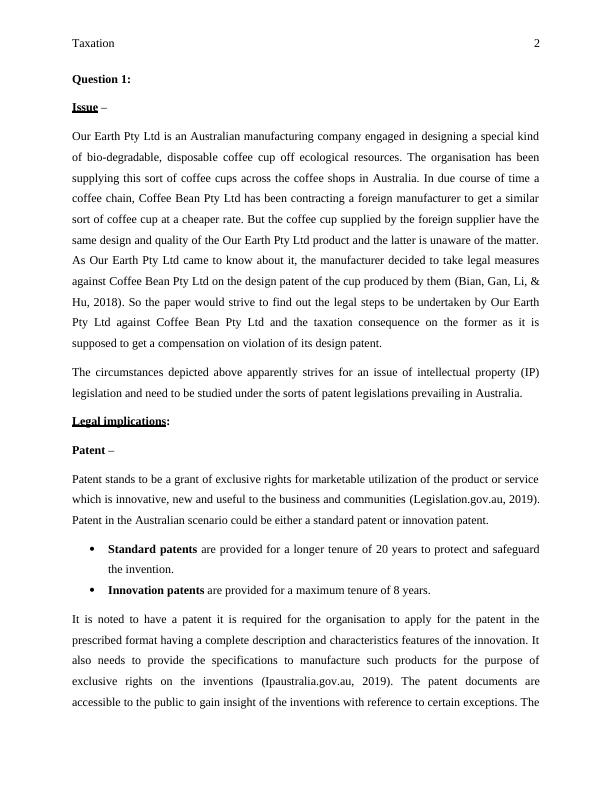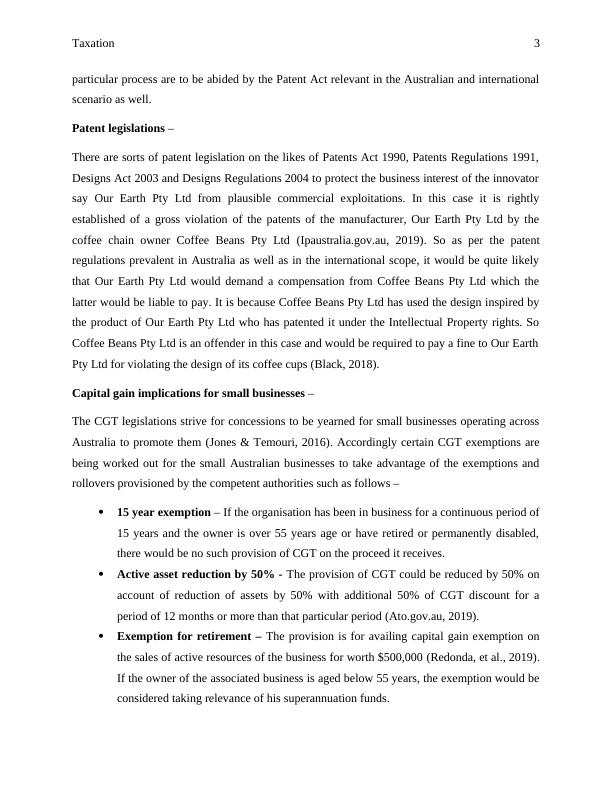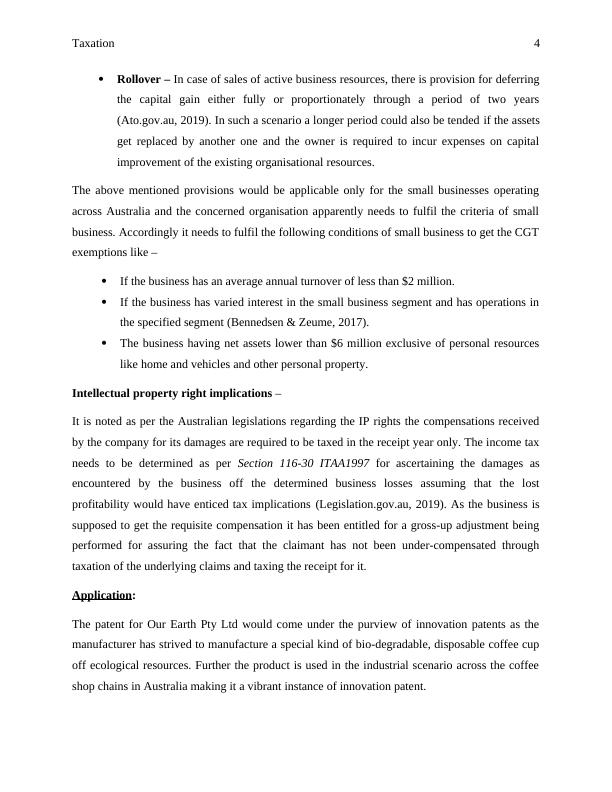Taxation Implications on Intellectual Property Rights and Subdivided Farmland
14 Pages4539 Words225 Views
Added on 2023-04-22
About This Document
This document discusses the legal implications of intellectual property rights and subdivided farmland on taxation. It covers topics such as patent legislation, capital gain implications for small businesses, and sub-division of farmland. It also provides advice for small businesses on how to avail tax exemptions under CGT.
Taxation Implications on Intellectual Property Rights and Subdivided Farmland
Added on 2023-04-22
ShareRelated Documents
Running Head: Taxation 1
Taxation
Name:
Date:
Taxation
Name:
Date:

Taxation 2
Question 1:
Issue –
Our Earth Pty Ltd is an Australian manufacturing company engaged in designing a special kind
of bio-degradable, disposable coffee cup off ecological resources. The organisation has been
supplying this sort of coffee cups across the coffee shops in Australia. In due course of time a
coffee chain, Coffee Bean Pty Ltd has been contracting a foreign manufacturer to get a similar
sort of coffee cup at a cheaper rate. But the coffee cup supplied by the foreign supplier have the
same design and quality of the Our Earth Pty Ltd product and the latter is unaware of the matter.
As Our Earth Pty Ltd came to know about it, the manufacturer decided to take legal measures
against Coffee Bean Pty Ltd on the design patent of the cup produced by them (Bian, Gan, Li, &
Hu, 2018). So the paper would strive to find out the legal steps to be undertaken by Our Earth
Pty Ltd against Coffee Bean Pty Ltd and the taxation consequence on the former as it is
supposed to get a compensation on violation of its design patent.
The circumstances depicted above apparently strives for an issue of intellectual property (IP)
legislation and need to be studied under the sorts of patent legislations prevailing in Australia.
Legal implications:
Patent –
Patent stands to be a grant of exclusive rights for marketable utilization of the product or service
which is innovative, new and useful to the business and communities (Legislation.gov.au, 2019).
Patent in the Australian scenario could be either a standard patent or innovation patent.
Standard patents are provided for a longer tenure of 20 years to protect and safeguard
the invention.
Innovation patents are provided for a maximum tenure of 8 years.
It is noted to have a patent it is required for the organisation to apply for the patent in the
prescribed format having a complete description and characteristics features of the innovation. It
also needs to provide the specifications to manufacture such products for the purpose of
exclusive rights on the inventions (Ipaustralia.gov.au, 2019). The patent documents are
accessible to the public to gain insight of the inventions with reference to certain exceptions. The
Question 1:
Issue –
Our Earth Pty Ltd is an Australian manufacturing company engaged in designing a special kind
of bio-degradable, disposable coffee cup off ecological resources. The organisation has been
supplying this sort of coffee cups across the coffee shops in Australia. In due course of time a
coffee chain, Coffee Bean Pty Ltd has been contracting a foreign manufacturer to get a similar
sort of coffee cup at a cheaper rate. But the coffee cup supplied by the foreign supplier have the
same design and quality of the Our Earth Pty Ltd product and the latter is unaware of the matter.
As Our Earth Pty Ltd came to know about it, the manufacturer decided to take legal measures
against Coffee Bean Pty Ltd on the design patent of the cup produced by them (Bian, Gan, Li, &
Hu, 2018). So the paper would strive to find out the legal steps to be undertaken by Our Earth
Pty Ltd against Coffee Bean Pty Ltd and the taxation consequence on the former as it is
supposed to get a compensation on violation of its design patent.
The circumstances depicted above apparently strives for an issue of intellectual property (IP)
legislation and need to be studied under the sorts of patent legislations prevailing in Australia.
Legal implications:
Patent –
Patent stands to be a grant of exclusive rights for marketable utilization of the product or service
which is innovative, new and useful to the business and communities (Legislation.gov.au, 2019).
Patent in the Australian scenario could be either a standard patent or innovation patent.
Standard patents are provided for a longer tenure of 20 years to protect and safeguard
the invention.
Innovation patents are provided for a maximum tenure of 8 years.
It is noted to have a patent it is required for the organisation to apply for the patent in the
prescribed format having a complete description and characteristics features of the innovation. It
also needs to provide the specifications to manufacture such products for the purpose of
exclusive rights on the inventions (Ipaustralia.gov.au, 2019). The patent documents are
accessible to the public to gain insight of the inventions with reference to certain exceptions. The

Taxation 3
particular process are to be abided by the Patent Act relevant in the Australian and international
scenario as well.
Patent legislations –
There are sorts of patent legislation on the likes of Patents Act 1990, Patents Regulations 1991,
Designs Act 2003 and Designs Regulations 2004 to protect the business interest of the innovator
say Our Earth Pty Ltd from plausible commercial exploitations. In this case it is rightly
established of a gross violation of the patents of the manufacturer, Our Earth Pty Ltd by the
coffee chain owner Coffee Beans Pty Ltd (Ipaustralia.gov.au, 2019). So as per the patent
regulations prevalent in Australia as well as in the international scope, it would be quite likely
that Our Earth Pty Ltd would demand a compensation from Coffee Beans Pty Ltd which the
latter would be liable to pay. It is because Coffee Beans Pty Ltd has used the design inspired by
the product of Our Earth Pty Ltd who has patented it under the Intellectual Property rights. So
Coffee Beans Pty Ltd is an offender in this case and would be required to pay a fine to Our Earth
Pty Ltd for violating the design of its coffee cups (Black, 2018).
Capital gain implications for small businesses –
The CGT legislations strive for concessions to be yearned for small businesses operating across
Australia to promote them (Jones & Temouri, 2016). Accordingly certain CGT exemptions are
being worked out for the small Australian businesses to take advantage of the exemptions and
rollovers provisioned by the competent authorities such as follows –
15 year exemption – If the organisation has been in business for a continuous period of
15 years and the owner is over 55 years age or have retired or permanently disabled,
there would be no such provision of CGT on the proceed it receives.
Active asset reduction by 50% - The provision of CGT could be reduced by 50% on
account of reduction of assets by 50% with additional 50% of CGT discount for a
period of 12 months or more than that particular period (Ato.gov.au, 2019).
Exemption for retirement – The provision is for availing capital gain exemption on
the sales of active resources of the business for worth $500,000 (Redonda, et al., 2019).
If the owner of the associated business is aged below 55 years, the exemption would be
considered taking relevance of his superannuation funds.
particular process are to be abided by the Patent Act relevant in the Australian and international
scenario as well.
Patent legislations –
There are sorts of patent legislation on the likes of Patents Act 1990, Patents Regulations 1991,
Designs Act 2003 and Designs Regulations 2004 to protect the business interest of the innovator
say Our Earth Pty Ltd from plausible commercial exploitations. In this case it is rightly
established of a gross violation of the patents of the manufacturer, Our Earth Pty Ltd by the
coffee chain owner Coffee Beans Pty Ltd (Ipaustralia.gov.au, 2019). So as per the patent
regulations prevalent in Australia as well as in the international scope, it would be quite likely
that Our Earth Pty Ltd would demand a compensation from Coffee Beans Pty Ltd which the
latter would be liable to pay. It is because Coffee Beans Pty Ltd has used the design inspired by
the product of Our Earth Pty Ltd who has patented it under the Intellectual Property rights. So
Coffee Beans Pty Ltd is an offender in this case and would be required to pay a fine to Our Earth
Pty Ltd for violating the design of its coffee cups (Black, 2018).
Capital gain implications for small businesses –
The CGT legislations strive for concessions to be yearned for small businesses operating across
Australia to promote them (Jones & Temouri, 2016). Accordingly certain CGT exemptions are
being worked out for the small Australian businesses to take advantage of the exemptions and
rollovers provisioned by the competent authorities such as follows –
15 year exemption – If the organisation has been in business for a continuous period of
15 years and the owner is over 55 years age or have retired or permanently disabled,
there would be no such provision of CGT on the proceed it receives.
Active asset reduction by 50% - The provision of CGT could be reduced by 50% on
account of reduction of assets by 50% with additional 50% of CGT discount for a
period of 12 months or more than that particular period (Ato.gov.au, 2019).
Exemption for retirement – The provision is for availing capital gain exemption on
the sales of active resources of the business for worth $500,000 (Redonda, et al., 2019).
If the owner of the associated business is aged below 55 years, the exemption would be
considered taking relevance of his superannuation funds.

Taxation 4
Rollover – In case of sales of active business resources, there is provision for deferring
the capital gain either fully or proportionately through a period of two years
(Ato.gov.au, 2019). In such a scenario a longer period could also be tended if the assets
get replaced by another one and the owner is required to incur expenses on capital
improvement of the existing organisational resources.
The above mentioned provisions would be applicable only for the small businesses operating
across Australia and the concerned organisation apparently needs to fulfil the criteria of small
business. Accordingly it needs to fulfil the following conditions of small business to get the CGT
exemptions like –
If the business has an average annual turnover of less than $2 million.
If the business has varied interest in the small business segment and has operations in
the specified segment (Bennedsen & Zeume, 2017).
The business having net assets lower than $6 million exclusive of personal resources
like home and vehicles and other personal property.
Intellectual property right implications –
It is noted as per the Australian legislations regarding the IP rights the compensations received
by the company for its damages are required to be taxed in the receipt year only. The income tax
needs to be determined as per Section 116-30 ITAA1997 for ascertaining the damages as
encountered by the business off the determined business losses assuming that the lost
profitability would have enticed tax implications (Legislation.gov.au, 2019). As the business is
supposed to get the requisite compensation it has been entitled for a gross-up adjustment being
performed for assuring the fact that the claimant has not been under-compensated through
taxation of the underlying claims and taxing the receipt for it.
Application:
The patent for Our Earth Pty Ltd would come under the purview of innovation patents as the
manufacturer has strived to manufacture a special kind of bio-degradable, disposable coffee cup
off ecological resources. Further the product is used in the industrial scenario across the coffee
shop chains in Australia making it a vibrant instance of innovation patent.
Rollover – In case of sales of active business resources, there is provision for deferring
the capital gain either fully or proportionately through a period of two years
(Ato.gov.au, 2019). In such a scenario a longer period could also be tended if the assets
get replaced by another one and the owner is required to incur expenses on capital
improvement of the existing organisational resources.
The above mentioned provisions would be applicable only for the small businesses operating
across Australia and the concerned organisation apparently needs to fulfil the criteria of small
business. Accordingly it needs to fulfil the following conditions of small business to get the CGT
exemptions like –
If the business has an average annual turnover of less than $2 million.
If the business has varied interest in the small business segment and has operations in
the specified segment (Bennedsen & Zeume, 2017).
The business having net assets lower than $6 million exclusive of personal resources
like home and vehicles and other personal property.
Intellectual property right implications –
It is noted as per the Australian legislations regarding the IP rights the compensations received
by the company for its damages are required to be taxed in the receipt year only. The income tax
needs to be determined as per Section 116-30 ITAA1997 for ascertaining the damages as
encountered by the business off the determined business losses assuming that the lost
profitability would have enticed tax implications (Legislation.gov.au, 2019). As the business is
supposed to get the requisite compensation it has been entitled for a gross-up adjustment being
performed for assuring the fact that the claimant has not been under-compensated through
taxation of the underlying claims and taxing the receipt for it.
Application:
The patent for Our Earth Pty Ltd would come under the purview of innovation patents as the
manufacturer has strived to manufacture a special kind of bio-degradable, disposable coffee cup
off ecological resources. Further the product is used in the industrial scenario across the coffee
shop chains in Australia making it a vibrant instance of innovation patent.

End of preview
Want to access all the pages? Upload your documents or become a member.
Related Documents
Taxation Law: Tax Consequences of Compensation and Property Salelg...
|12
|3942
|79
Taxation Assignmentlg...
|19
|5015
|38
Taxation 1lg...
|15
|4535
|1
Tax Obligations for Subdividing and Selling Landlg...
|14
|4136
|75
